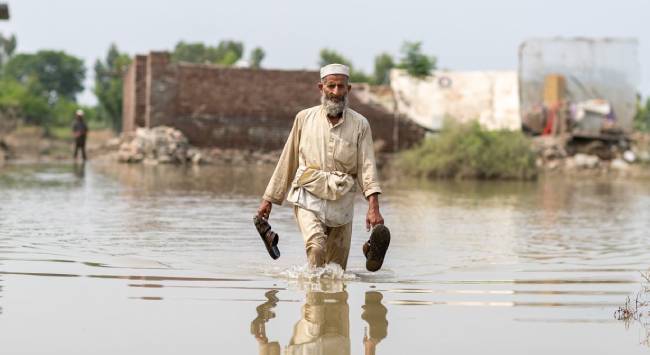Summary
The issue of climate change has acquired renewed salience in Pakistan with the increasing frequency of climate-induced disasters. Pakistan’s growing population is further anticipated to place increasing pressure on the environment while diminishing natural resources and rising pollution look to threaten life, livelihoods and the quality of life in the country. While advances in addressing the climate crisis at the international and domestic levels have occurred in charting pathways forward, inaction and resistance to change remain the problem.
According to projections by the United Nations (UN), Pakistan’s population is expected to reach 380 million by 2050 from the current 231 million people. This rate of growth is anticipated to place increasing pressure on Pakistan’s diminishing natural resources and, at the same time, create further environmental and climate-related challenges, including pollution, water shortages and the depletion and contamination of natural resources. These are set to place increasing pressure on Pakistan’s society, quality of life and economy.
Pakistan is ranked the fourth most polluted country in the world, according to the Air Quality Life Index, with Karachi ranking as the world’s fourth most polluted city. Moreover, smog remains a worsening issue in Punjab, with the provincial government imposing an environmental emergency in Lahore last month over concerns over air quality. Water is considered Pakistan’s most valuable natural resource but, according to the Pakistan Institute of Development of Economics, water scarcity in Pakistan is at a ‘frightening’ level, with the country ranking 14 out of 17 of the extremely high water-risk countries of the world. Mismanagement, poor regulation and pollution have exacerbated the depletion of Pakistan’s water sources. Despite the magnitude of the crisis, the situation has acquired little media attention.
Pakistan’s per capita emissions is one of the lowest in the world but the country ranks in the top 10 most affected by climate change in the last 20 years, with recurrent floods, droughts, desertification, glacial melt and sea water intrusion. In June 2022, Pakistan began witnessing record monsoonal rainfall and flooding across areas in all four provinces of the country. The torrential downpour impacted major urban centres in July 2022, including Karachi, the country’s financial capital, as well as submerging villages in south-west Balochistan. By late August 2022, the Pakistan government declared a national emergency with its Federal Minister for Climate Change, Senator Sherry Rehman, describing the situation as a climate-induced humanitarian disaster of epic proportions. In September 2022, Prime Minister Shehbaz Sharif, in his address to the UN General Assembly’s annual high-level debate, stressed that the country had “never seen a starker and more devastating example of the impact of global warming”.
The National Disaster Management Authority of Pakistan reported in the same month that the rains had affected 33 million people, killed 1,739 and injured 12,867. The flooding further damaged more than 13,000 kilometres of roads, 400 bridges, two million houses and a million in livestock. An estimated five million people continue to be exposed to or living close to flooded areas in January this year. In Sindh, some 89,000 people remain displaced, while in Balochistan, more than 116,000 people remain registered as displaced in the province. Overall, eight million people remain homeless and, in many areas, waters have yet to recede and are likely to remain at flood levels for months to come.
As agricultural lands remain submerged, the impact on Pakistan’s food security is something many have speculated as Pakistan’s next emergency. Agriculture contributes to 23 per cent of Pakistan’s gross domestic product, utilises 43 per cent of its labour force and is an important source of foreign exchange earnings. With the overflow of riverbanks, millions of acres of crops and orchards were destroyed, seeds were washed away and so too were the livelihoods of many.
The 27th session of the United Nations Climate Change Conference (COP27) in Sharm el-Sheikh Egypt in November 2022 raised the question of who will pay for the alarming, manifold and disproportionate impact of climate change on countries most often in the Global South. The protracted debates culminated in an agreement to establish a Loss and Damage Fund aimed at providing financial assistance to countries in the frontline of climate disasters. Despite the historic nature of the Fund, the deal has been labelled as ‘modest’ and important questions about how the assistance will be operationalised remain unsettled. The Summit also failed to garner commitment from countries in phasing out or phasing down of fossil fuels.
Within Pakistan, the issue of climate change has acquired increasing salience in public and political discourse. Numerous government initiatives have been put forward, including the National Climate Change Policy, 2012 and the Framework for Implementation of Climate Change Policy (2014-2030), which have been announced by the Ministry of Climate Change. The issue, however, is not the shortage of climate change laws and initiatives but rather, as the Asghar Leghari v Pakistan case revealed, government inaction and failures of coordination and implementation. The increasing frequency of climate-induced disasters impacting Pakistan means that more needs to be done at the domestic and international levels.
. . . . .
Dr Imran Ahmed is a Visiting Research Fellow at the Institute of South Asian Studies (ISAS), an autonomous research institute in the National University of Singapore (NUS). He can be contacted at iahmed@nus.edu.sg. The author bears full responsibility for the facts cited and opinions expressed in this paper.
Pic Credit: SwedeninPK Twitter Account
-
 More From :
More From :
-
 Tags :
Tags :
-
 Download PDF
Download PDF


